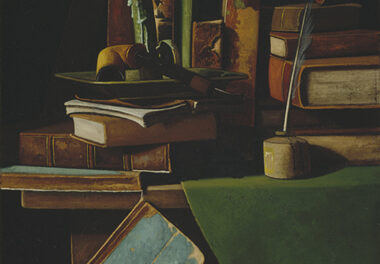The Triad is lucky to have several fine institutions and performing ensembles that focus exclusively on new and recent music. NM_GSO (New Music Greensboro) is the season-long reincarnation of the UNCG New Music Festival, which operated to national acclaim for a decade. Directed by Professor of Composition Mark Engebretson, NM_GSO highlights the efforts of local, national, and international artists who are contributing to the expansion of the Classical performance and composition tradition.
This season’s penultimate NM_GSO concert was performed by UNCG’s own Present~Continuous. Directed by Engebretson’s colleague Alejandro Rutty, Present~Continuous offers advanced students the opportunity to perform everything from avant-garde classics of the 20th century to brand new compositions by UNCG students.
This sharp 11-piece group combines the precision and virtousity of a classical chamber ensemble with the expansive, colorful, and dynamic sounds of the 20th and 21st centuries. Joining the traditional winds, strings, and piano are electric guitar, percussion, and computer. Rutty both conducts and performs at the keyboard, student composer Shawn Milloway serves as sound technician, computer wizard, and synthesizer performer, and a host of graduate and advanced undergraduate performers fill out the ensemble on acoustic instruments. This is a sleek and fluid ensemble capable of quickly changing configuration to meet the needs of vastly differing works of art.
Friday night’s concert featured an experimental classic, three recent pieces by living professional composers, and two premieres by UNCG students. Kicking off the show was “Little Green Pop” by Rome Prize winner Sean Friar. One quick wave from Rutty’s baton and UNCG’s Organ Hall was filled with the ringing, shimmering sound of winds and vibraphone. Electric guitar and piano emerged from the texture, weaving together so closely that it was often difficult to distinguish between them. Robert Harrison’s Fender Telecaster sounded sweet and chimey, while Walton Lott’s touch at the Steinway was sharp but expressive.
Microphones placed near the ensemble sent the sound of the instruments through a computer, which added digital reverberation and spit the signal back out through speakers placed behind the group. The effect during sparser moments was magnificent, but the sound tended to get muddled and confused rather than warmly amplified during louder passages; the confusion was somewhat alleviated, however, by the intimacy of the Organ Hall.
The evening’s second work was, for my tastes, the most successful composition, Anna Clyne‘s Steelworks. Joining a trio of flute, bass clarinet, and percussion was an electronic backing track built from sound samples of factory machinery and interviews with Brooklyn steel workers. This impressive 15-minute work investigated various aspects of the steel industry: the intimidating, elemental nature of the raw material, the economic and industrial power of manufacturing, and the replacement of human workers with machines.
The work’s star performer was Korry Friend, who got a legitimate cardio workout playing marimba while kicking a bass drum. Abigail Simoneau, flute and piccolo, added a beautiful metallic shimmer to the the upper register, while Asher Carlson held down the low end with reedy, punchy tone from his bass clarinet.
Clyne deserves praise not only for the composition’s sonic success, but also for honestly exploring different facets of the steel industry without judgment or indictment. This is no two-dimensional cautionary tale, but rather a complex response to a complex industry.
Earle Brown‘s “December 1952” is a landmark work in the fields of graphic notation and experimental improvisation. The score consists of a single page of short, perpendicular lines of varying thickness.
Though open and improvisatory, “December 1952” is not without rigor. Conceptually, it is an homage to Alexander Calder’s mobiles: it encourages the instrumentalists to envision the work as fluid structure with aesthetic focus but varying scale and form.
Present~Continuous, with Rutty now at the piano, performed with delicacy and reserve, remaining true to the score’s sparseness and angularity.
Following Carl Schimmel‘s energetic “The Alphabet Turn’d Posture Master” were the evening’s two student works. Timothy Burgess was first with “Elena,” a gentle but rich piece with a striking harmonic language. Making use of the full ensemble, “Elena” used sophisticated interweaving phrases in which instruments faded in and out of the texture quasi-canonically.
Laptopist Shawn Milloway closed the concert with “Two Despotic Regimes.” This ironic and maniacal piece combined twisted marches, tortured rock/pop grooves, and moments of genuine sweetness. Placed alongside each other, the Milloway and Burgess pieces showed both the sonic variety and the craftiness of young contemporary musical minds.
If Present~Continuous is any indication of the state of contemporary composition and performance, there is cause for music lovers to celebrate: these are stellar young musicians with open minds operating under expert guidance. In a huge and still-growing world of kaleidoscopic musical languages and deep talent, UNCG’s composers and performers are fostering and maintaining an exquisite level of musicianship. Bravi!











